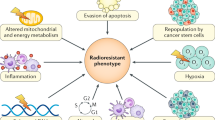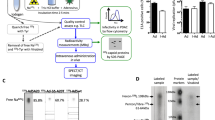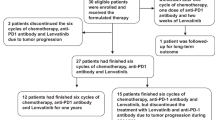Abstract
Radiosensitization of human gastrointestinal tumors by 5-fluorouracil (5-FU) has been studied in vitro and clinically in human cancer therapy trials. The bacterial enzyme cytosine deaminase (CD) converts the nontoxic prodrug 5-fluorocytosine (5-FC) into 5-FU. Human colon cancer cells stably expressing CD have been shown by other investigators to be sensitized to radiation following treatment with 5-FC. We previously used an adenoviral vector under control of the cytomegalovirus promoter (AdCMVCD) encoding the CD gene in combination with 5-FC and a single fraction of radiation exposure to enhance cytotoxicity to human cholangiocarcinoma cells in vitro and in vivo. The purpose of this study was to determine whether AdCMVCD infection and 5-FC with multiple fraction low-dose radiotherapy results in enhanced cytotoxicity. In the present study, we utilized AdCMVCD and 5-FC with single fraction radiotherapy to demonstrate enhanced cytotoxicity to WiDr human colon carcinoma cells in vitro. Additionally, we tested this gene therapy/prodrug treatment strategy employing a fractionated radiation dosing schema in animal models of WiDr colon carcinoma and SK-ChA-1 cholangiocarcinoma. A prolonged WiDr tumor regrowth delay was obtained with AdCMVCD infection in combination with systemic delivery of 5-FC and fractionated external beam radiation therapy compared with control animals treated without radiation, without 5-FC, or without AdCMVCD. The results of treatment with AdCMVCD + 5-FC + radiation therapy to cholangiocarcinoma xenografts were equivalent to those obtained with systemic 5-FU administration + radiation. Thus, the use of AdCMVCD can be effectively combined with clinically relevant 5-FC and radiation administration schemes to achieve enhanced tumor cell killing and increased control of established tumors of human gastrointestinal malignancies.
This is a preview of subscription content, access via your institution
Access options
Subscribe to this journal
Receive 12 print issues and online access
$259.00 per year
only $21.58 per issue
Buy this article
- Purchase on Springer Link
- Instant access to full article PDF
Prices may be subject to local taxes which are calculated during checkout







Similar content being viewed by others
References
Lawrence TS, Tepper JE . Combined radiation therapy and chemotherapy – 5-FU and FUdR Semin Radiat Oncol 1997 7: 247–334
Hsue V et al. A phase I study of combined radiation therapy with 5-fluorouracil and low dose folinic acid in patients with locally advanced pancreatic or biliary carcinoma Int J Radiat Oncol Biol Phys 1996 34: 445–450
Oberfield RA, Rossi RL . The role of chemotherapy in the treatment of bile duct cancer World J Surg 1988 12: 105–108
Buchsbaum DJ et al. Approaches to enhance cancer radiotherapy employing gene transfer methods Gene Therapy 1996 3: 1042–1068
Weichselbaum RR et al. Gene therapy targeted by radiation preferentially radiosensitizes tumor cells Cancer Res 1994 54: 4266–4269
Kim JH, Kim SH, Brown SL, Freytag SO . Selective enhancement by an antiviral agent of the radiation-induced cell killing of human glioma cells transduced with HSV-tk gene Cancer Res 1994 54: 6053–6056
Khil MS et al. Radiosensitization by 5-fluorocytosine of human colorectal carcinoma cells in culture transduced with cytosine deaminease gene Clin Cancer Res 1996 2: 53–57
Pederson LC et al. Molecular chemotherapy combined with radiation therapy enhances killing of cholangiocarcinoma cells in vitro and in vivo Cancer Res 1997 57: 4325–4332
Spitz FR et al. Adenoviral-mediated wild-type p53 gene expression sensitizes colorectal cancer cells to ionizing radiation Clin Cancer Res 1996 2: 1665–1671
Huber BE et al. In vivo antitumor activity of 5-fluorocytosine on human colorectal carcinoma cells genetically modified to express cytosine deaminase Cancer Res 1993 53: 4619–4626
Pederson LC et al. Combining cytosine deaminase expression, 5-fluorocytosine exposure, and radiotherapy increases cytotoxicity to cholangiocarcinoma cells J Gastrointest Surg 1998 2: 283–291
Rogulski KR, Kim JH, Kim SH, Freytag SO . Glioma cells transduced with an Escherichia coli CD/HSV-1 TK fusion gene exhibit enhanced metabolic suicide and radiosensitivity Hum Gene Ther 1997 8: 73–85
Dong Y et al. In vivo replication-deficient adenovirus vector-mediated transduction of the cytosine deaminase gene sensitizes glioma cells to 5-fluorocytosine Hum Gene Ther 1996 7: 713–720
Hirschowitz EA et al. In vivo adenovirus-mediated gene transfer of the Escherichia coli cytosine deaminase gene to human colon carcinoma-derived tumors induces chemosensitivity to 5-fluorocytosine Hum Gene Ther 1995 6: 1055–1063
Ohwada A, Hirschowitz EA, Crystal RG . Regional delivery of an adenovirus vector containing the Escherichia coli cytosine deaminase gene to provide local activation of 5-fluorocytosine to suppress the growth of colon carcinoma metastatic to liver Hum Gene Ther 1996 7: 1567–1576
Saunders K et al. Diffuse bile duct tumors: guidelines for management Am Surg 1991 57: 816–820
Vauthey J-N, Blumgart LH . Recent advances in the management of cholangiocarcinomas Semin Liver Dis 1994 14: 109–114
Denning C, Pitts JD . Bystander effects of different enzyme-prodrug systems for cancer gene therapy depend on differentpathways for intercellular transfer of toxic metabolites, a factor that will govern clinical choice of appropriate regimes Hum Gene Ther 1997 8: 1825–1835
Paillard F . Bystander effects in enzyme/prodrug gene therapy Hum Gene Ther 1997 8: 1733–1736
Becker TC et al. Use of recombinant adenovirus for metabolic engineering of mammalian cells Meth Cell Biol 1994 43: 161–189
Grizzle WE, Myers RB, Manne U, Srivastava S . Immunohistochemical evaluation of biomarkers in prostatic and colorectal neoplasia. In: Hanausek M, Walaszek Z (eds) John Walker's Methods in Molecular Medicine – Tumor Marker Protocols Humana Press: Totowa, NJ 1998 143–160
Grizzle WE et al. Factors affecting immunohistochemical evaluation of biomarker expression in neoplasia. In: Hanausek M, Walaszek Z (eds) John Walker's Methods in Molecular Medicine – Tumor Marker Protocols Humana Press: Totowa 1998 161–179
Manne U et al. Prognostic significance of Bcl-2 expression and p53 nuclear accumulation in colorectal adenocarcinoma Int J Cancer 1997 74: 346–358
Myers RB, Grizzle WE . Biomarker expression in prostatic intraepithelial neoplasia Eur Urol 1996 30: 153–166
Haack K et al. Detection of cytosine deaminase in genetically modified tumor cells by specific antibodies Hum Gene Ther 1997 8: 1395–1401
Acknowledgements
We acknowledge the efforts of Jonathan Harris, Helen Hurst and Craig Mullen for providing the CD plasmid construct pTH-CD500, which was used to construct AdCMVCD. We thank Sreekanth Kancharla, Sheila Bright, Christine Olsen, and Rob Stockard for excellent technical assistance, and Sally Lagan for manuscript preparation.
Author information
Authors and Affiliations
Rights and permissions
About this article
Cite this article
Stackhouse, M., Pederson, L., Grizzle, W. et al. Fractionated radiation therapy in combination with adenoviral delivery of the cytosine deaminase gene and 5-fluorocytosine enhances cytotoxic and antitumor effects in human colorectal and cholangiocarcinoma models. Gene Ther 7, 1019–1026 (2000). https://doi.org/10.1038/sj.gt.3301196
Received:
Accepted:
Published:
Issue Date:
DOI: https://doi.org/10.1038/sj.gt.3301196
Keywords
This article is cited by
-
Isocytosine deaminase Vcz as a novel tool for the prodrug cancer therapy
BMC Cancer (2019)
-
Adenoviral-mediated imaging of gene transfer using a somatostatin receptor-cytosine deaminase fusion protein
Cancer Gene Therapy (2015)
-
Recombinant vaccinia virus GLV-1h68 is a promising oncolytic vector in the treatment of cholangiocarcinoma
Cancer Gene Therapy (2015)
-
Escherichia coli nitroreductase plus CB1954 enhances the effect of radiotherapy in vitro and in vivo
Gene Therapy (2008)
-
Mutation of Escherichia coli cytosine deaminase significantly enhances molecular chemotherapy of human glioma
Gene Therapy (2007)



